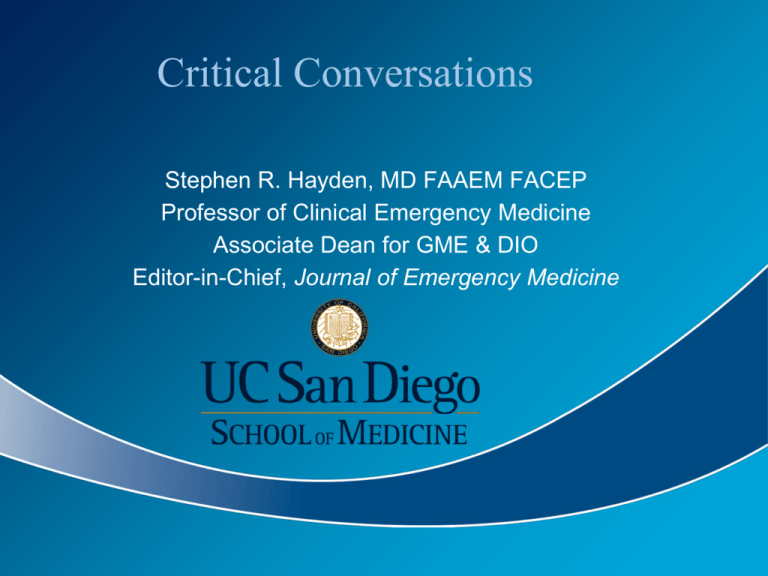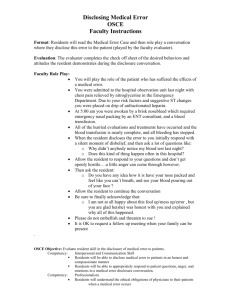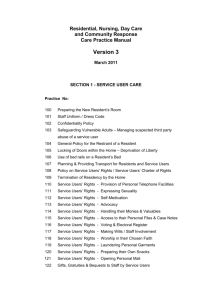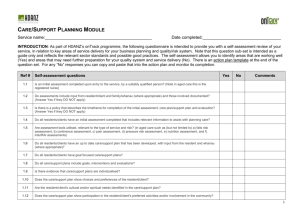Critical Conversations - Council of Emergency Medicine Residency
advertisement

Critical Conversations Stephen R. Hayden, MD FAAEM FACEP Professor of Clinical Emergency Medicine Associate Dean for GME & DIO Editor-in-Chief, Journal of Emergency Medicine Objectives • Identify common resident scenarios requiring further discussion with program leadership • Discuss techniques of effective communication; What are the right things to say? What traps should you avoid? • Identify the appropriate setting to have conversations • Describe methods that can be utilized for follow up on the critical conversations • Provide a basic blueprint for critical conversations Here is a Case to Think About... Take Home Messages • You are not alone! • Ask for help from your DIO, Chair, other PDs • Turn to your program and institutional policies Familiarize yourself with them • Know your institutional resources Physician Well Being Committee Ombudsperson Crisis intervention, counseling, campus police Take Home Messages • Separate the complaint from the complainant Even if resident is a whiner, they may be right • Don't let personal bias/relationship cloud your judgment, make your decisions based on principles Patient safety comes first • Reality check: ask yourself; if your mother read about this in the newspaper, what would she think about the way you handled the situation? Three Categories We’ll Discuss • Resident has a problem • Someone else is causing a problem for the resident • Resident observes a problem in someone else Background • If you don’t think you are going to see problem residents during your career as a PD; think again! • ABIM estimates 8-15% of residents have serious problems during their training period • Only 2% of problem residents come forward themselves • 1% of housestaff required a leave of absence 12% of these needed inpatient psychiatric care 2% underwent chemical dependency programs 5% attempted suicide Background • Canadian study of 2000 housestaff, 23% had some degree of depression and emotional distress • 40% of IM residents experienced problems with spouse • AMA reported impairment rates among physicians approximately 3% for ETOH, 1-2% for other substances • National survey of residents 5% daily use of ETOH 0.3% marijuana, 3.7% benzodiazepines, 1.4% cocaine in the last month Background • Emergency Medicine survey done during 2006 Inservice Training Examination (McBeth, et al) • 56% response rate, 2,397 EM residents • Past year use of marijuana is 11.8% • Past year use of cocaine 1.1% • 5% reported daily use of ETOH • 12.6% of residents indicate consumption of ETOH has increased during residency Scenario 1 • After conference one morning a resident catches you in the hallway and asks if they can talk to you for a minute. He says, “I need to tell you something before you hear it from someone else.” He continues, “I was caught trying to fill a prescription for Ambien using one of the ED attending’s prescriptions.” • This was the third time the resident had presented an Rx to a pharmacy and the pharmacist called the ED attending to verify. The ED attending denied the Rx Scenario 1 • What are the issues involved in this scenario? • How do you approach this conversation? Scenario 1 • First; get out of the hallway; go to your office or a private location nearby • Second; inform resident that if he reveals to you information that involves potential harm to someone, as an institutional official you may have to take action • Next explore the circumstances “Tell me more about the situation…what happened?” Use open ended questions Let them tell their story Scenario 1 • Seek to understand more fully “What are the barriers you are experiencing to manage the situation?” • Ask, “What do you want to happen by telling me this?” • Discuss next steps “Ok, let's talk about how this may go...” Inform your Department Chair Refer the resident to your equivalent of the Physician Well Being Committee Scenario 1 • If resident is placed on leave/referred to a chemical dependency program inform your GME Office/DIO • Will have to do damage control Conversation with other residents and faculty “An issue arose and resident is being referred for help and counseling; please respect their privacy” Scenario 1 – Part 2 • Resident re-enters the residency after successfully completing an inpatient treatment program • Several months later, an attending tells you the resident was over at her house and now a bottle of Ambien in their medicine cabinet is gone and she is sure it was there before the resident came over Scenario 1 – Part 2 • What are the issues involved in part 2? • How do you approach this conversation? • What do you do next? Scenario 1 – Part 2 • Issues/questions: Is the resident using Ambien again? How did he obtain it? Did the resident violate his re-entry contract? Should disciplinary action be initiated? • Discuss with PWBC May require specialized drug testing • Meet with resident • May have grounds for dismissal Discuss with Chair/DIO Scenario 2 • As you are walking out the door of the ED after a long Saturday night shift, a resident follows you to the parking lot and asks to speak to you for a moment. She says, “I am afraid of Allen, he threatened me in the resident’s office the other day. He must have overhead me talking to the chief resident complaining that he doesn’t have to work nightshifts because of having to make an accommodation for him.” Scenario 2 • “We all know his medical license was put on probation because he is crazy and has ‘Anger Management’ issues and when we were alone in the office yesterday he said, ‘If you don’t stop complaining about me and stay out of my business, I’ll…’ but he never finished the sentence. I am afraid he will come after me so please keep this confidential!” • The complainant transferred to your program because she was attacked by a patient and ultimately felt she could not continue in that program Scenario 2 • Both residents have issues in this scenario; what are they and how do you adjudicate them? • How do you approach this conversation(s)? Scenario 2 • Find a private place to discuss; go to your office or a private location nearby - parking lot is not ideal • May not be able to deal fully with situation at this time “Here is the time I have now but I know this is important, if we need more time I am available to you, I will make time for you...” • At this first encounter must triage the situation “Do you feel you have a safe environment tonight?” What action is required now vs. later? Scenario 2 • Inform resident that if she reveals to you information that involves potential harm to someone, as an institutional official you may have to take action • Explore the situation further “Tell me more about this encounter… “Help me to understand what led to this…” Scenario 2 • Ask, “What do you want to happen by telling me this?” Be clear what her expectations are Assess how much might be jealousy on her part • Develop options with her Talk to other resident involved (Allen) “Here is a way I can do this without letting the other resident know we had this conversation” Discretely talk to other residents and faculty Has anyone else had problems Allen? Scenario 2 • This case was ultimately referred to the Behavioral Threat Assessment Team; low risk threat • PD rearranged the schedule so the two residents had minimal contact for a couple of rotations • Subsequently engaged in team building activities • To make sure remaining residents were not unduly burdened with nightshifts program increased faculty coverage and offered residents a bonus for voluntary additional nightshifts Blueprint for Critical Conversations • Step 1 Find a private place to explore the situation further Don't wait or put it off, make the time ASAP Can set parameters; Here is the time I have now but I know this is important, if we need more time I am available to you, I will make time for you... Blueprint • Step 2 Let them tell their story; "What can I do to help?" Caveat: You may have to stop them, or if they start by asking for confidentiality explain limits; “If you relate something to me that is a threat to patient safety or danger to someone else, as an institutional official I may have to take action.” "I want to be available to you as a resource but...“ Ask open ended questions Blueprint • Step 3 Ask them what they want to have happen by sharing this information with you Be clear what action they want you to take Discuss what their expectations are and what they are willing to do to achieve these Or do they just want to vent… Blueprint • Step 4 Triage the situation; is action required right now? Develop options with them; give residents the tools to handle such situations in the future Empowers them, lets them take some control Tell them what you can and cannot do; be honest Lay out next steps so they know what will happen It often helps to refer to program/institutional policy Useful Phrases/Questions • • • • • Let's clarify the purpose of this conversation... I want to be available to you as a resource but... Help me to understand... Ok, let's talk about how this may go... What are the barriers you are experiencing that are preventing you from resolving this situation... • What is making this hard for you to tell me, are you concerned about retaliation? Useful Phrases/Questions • I will walk the walk with you; I can't guarantee the outcome but I will do everything I can to… • Would you like for me to have a conversation with someone (faculty member, resident, etc.) I don't have to say it is you Here is a way I can do it without letting anyone know you came to me Traps to Avoid • Don't diagnose the problem right off the bat Don't be a doctor, they need someone to listen Seek first to understand, then be understood Don't provide an immediate prescription Keep your mouth shut initially and don't use all their air time; time yourself if you have to Traps • He is a rock star so he gets a pass… • This just sounds like a personality conflict… • That is just the culture of the department and the way they do things… • Remember, if the situation doesn’t feel right it probably isn’t Trust your gut! Let’s Bring it Home • Beginning Scenario resolution: The PD triaged the situation and determined that the resident needed to be extracted Resident was pulled from the trauma service to cover “a sick call at another ED” Further investigation was initiated Ultimately the research project was shut down Surgeon was asked to “retire” Final Thoughts • Remember there are two sides to every conflict Before taking action determine whether you should seek the opposite viewpoint • Be a good listener; fully understand the situation • Be very clear about what they are asking you to do • Don't just let them dump responsibility on you, have to develop a partnership with them to move forward • Look at this as an opportunity to guide, mentor, and coach residents and shape future leaders Final Thoughts You will be the Rock Star if you learn to navigate these situations effectively!! References/Useful Reading • • • • • • • McBeth BD, Ankel FK, Ling LJ, Asplin BR, Mason EJ, Flottemesch TJ, McNamara RM. Substance use in emergency medicine training programs. Acad Emer Med. 2008 Jan;15(1):45-53 Jossey-Bass series: academic administrators guide to conflict resolution, authors: Sandra Cheldelin, and Ann Lucas Facilitating a collegial department in higher education, author: Robert Cipriano Yao DC, Wright SM. A National Survey of Internal Medicine Residency Program Directors Regarding Problem Residents. JAMA. 2000;284:1099–104 Smith JW, Denny WF, Witzke DB. Emotional impairment in internal medicine house staff. JAMA. 1986;255:1155–8 Hsu K, Marshall V. Prevalence of depression and distress in a large sample of Canadian residents, interns, and fellows. Am J Psychiatry. 1987;144:1561–6 Aach RD, Girard DE, Humphrey H, et al. Alcohol and other substance abuse and impairment among physicians in residency training. Ann Intern Med. 1992;116:245–54








